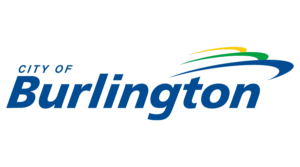
Background
The City of Burlington, situated in the Regional Municipality of Halton on the western shore of Lake Ontario, is home to a population of 186,948 as of 2021. Prior to its involvement in the Climate Action Cohort, the City laid a strong foundational work in climate action and asset management. This groundwork included the declaration of a Climate Emergency (2019), and the development of an Asset Management Plan (2021), a community Climate Action Plan (2020), a Corporate Energy and Emissions Management Plan (2019), a Climate Projections for Burlington report (2021), Climate Change Impacts story map, and the Climate Resilient Burlington (CRB) Plan (2022).
A climate emergency was declared for the purposes of deepening the City’s commitment to protecting its economy, environment, and community from climate change; and that Council and staff immediately apply a climate lens to its plans and actions including the Council strategic workplan and future budgets.
The CRB Plan aims to support adapting to warmer, wetter, and wilder weather by identifying actions to manage the increasing risks due to climate change. A key action item that was identified in the Plan was to integrate the climate impacts in Burlington’s Asset Management Plan and to build an internal team to champion work towards that goal.
The Importance of Climate Change
In 2014, the City of Burlington experienced a localized heavy rainfall event which delivered an exceptionally large amount of rain in a short period of time. The resulting flooding highlighted the vulnerabilities and limitations within the City’s infrastructure systems and the importance of adapting to climate change, particularly in areas of high risk to the community. With a projected warmer, wetter and wilder future climate, the CRB Plan identifies the climate hazards and adaptive measures the City can take to increase its resiliency to climate change.
The Approach
For the City of Burlington team, considering the risks that climate change poses to service delivery was a strategic entry point to integrating climate change into asset management. By focusing on risks, the team was able to:
- build a common language around asset management and climate change;
- focus on the services first (as opposed to assets); and
- focus on what was important and what action could be taken to minimize the risk.
For example, in order to build a common language, the team needed to consider: “Are we thinking about a single climate event, or the effects of increased or decreased frequency of the climate events?”. In this case the City chose to think about the trends.
“Focusing on the service that the assets provide will help identify what the risks look like to your municipality or organization and will initiate the conversation with colleagues, Council, and the public.”
The team identified that they wanted to focus on the risks to the transportation network, which helped them engage with the City’s subject matter experts on the topic. Based on climate hazards identified in the CRB Plan, the team identified the specific hazards that will pose the greatest risk to moving people and goods through Burlington.
Focusing on identifying the climate risks to one service area (transportation) helped the team to develop an approach that is tailored to the City’s needs, is replicable across other service areas, and is flexible to adaptation and improvement.
Using an Excel-based risk assessment tool that was acquired, the team assigned a likelihood and consequence score for each climate-service interaction. They used their previously developed Climate Change Vulnerability and Risk Assessment to assign likelihood scores and developed a customized framework to assign consequence scores. In the process, the team discovered that too much detail could be a roadblock. Using an established framework or tool and applying an iterative approach to one service helped the team to build alignment on what level of detail should be included. The resulting assessment allowed them to evaluate the impact of each climate hazard on the transportation service.
CNAM Members can watch this recorded webinar for free from Feb 8th, 2023, titled “Linking Climate, Risk, & Levels of Service – Mapping connections and making decisions” for more information on this Excel risk tool.
What’s Next
The City of Burlington aims to build on the risk assessment process by applying it to other services. This will help integrate the risks climate hazards pose across the organization to service delivery. Leveraging this process across other services will require including other subject matter experts within the organization from other departments, which will support building awareness of integrating climate change and asset management more broadly.
The City also asserted that to keep momentum going, the team will seek to share successes through conversation within teams and more broadly, ideally by sharing results with the Council and the public.
Lessons Learned
Using an approach that is consistent, flexible, simple, and that supports the multiple objectives of service delivery is critical to success. Having the right people in the room allowed the team to work through the nuanced considerations that are involved in integrating asset management and climate change, while maintaining adaptability.
It’s worth noting that an inconsistent approach can lead to more work. Before taking things too far, it is worth taking a step back to ensure the team has a common understanding of the purpose and scope of the work.
The experience is important – the Burlington team saw the working group as an opportunity to step outside of their daily work routines and leverage the expertise and knowledge-sharing opportunities offered through the CNAM cohort with other municipalities and organizations across Canada.
“You don’t have to have perfect data and information to begin the work! No matter where you are in your asset management journey, regardless of size, using a risk-based approach is a great entry point to integrating asset management and climate change from a high level.”
This initiative is offered through the Municipal Asset Management Program (MAMP), which is delivered by the Federation of Canadian Municipalities (FCM), and funded by the Government of Canada.

